Kampong Cham travel - Cambodia, Asia
Kampong Cham, is a charming riverside town situated along the Mekong River. Known for its historical significance and cultural attractions, Kampong Cham offers a blend of colonial architecture, ancient temples, and scenic landscapes. Kampong Cham is connected to the neighboring district of Tbong Khmum by the Kizuna Bridge, the first bridge in Cambodia to span the Mekong River, making it a crucial transportation hub for the area.
Population: Estimate 80,000 people (as of 2024)
Economy: While not yet a major tourist destination, Kampong Cham offers cultural and historical sites, such as the Wat Nokor temple and the Koh Pen Bamboo Bridge, along with natural attractions like forests and waterfalls. The government is focusing on tourism development to enhance the local economy.
Landmarks: Wat Nokor Bachey, Phnom Han Chey, Phnom Pros and Phnom Srey, Koh Pen Bamboo Bridge, Wat Joy T'maw, Preah Theat Teuk Chha, Abandoned US Airstrip
Cambodia
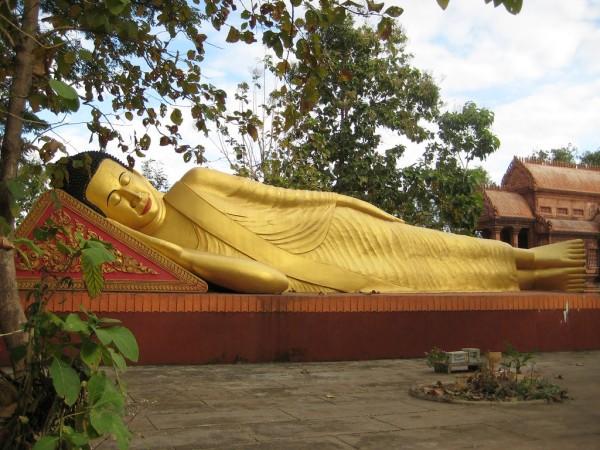
Overview of Kampong Cham
History & Cultural Influence
Kampong Cham's history dates back to ancient times, serving as a vital trade and transportation hub during the Funan and Chenla Kingdoms. Its strategic location along the Mekong River facilitated trade and cultural exchange, making it a melting pot of diverse influences. The Khmer Empire further enriched the region, with architectural marvels like Wat Nokor Bachey, which showcases a blend of Angkorian and Mahayana Buddhist styles, highlighting the area's historical significance.
During the French colonial period in the late 19th and early 20th centuries, Kampong Cham experienced significant development, evident in its well-preserved colonial architecture. This era introduced new social and economic dynamics, shaping the city’s urban landscape. However, the region also faced dark times during the Khmer Rouge regime, which left deep scars on the local population and landscape. Sites like the Killing Fields serve as solemn reminders of this tragic history.
The cultural influence of Kampong Cham is a reflection of its diverse population, which includes ethnic Khmers, Cham Muslims, and Chinese communities. This diversity is manifested in local customs, festivals, and culinary traditions. The province is known for its vibrant markets, where traditional crafts, textiles, and local delicacies can be found, showcasing the region's agricultural bounty.
Interaction with The Locals
The majority of residents are ethnic Khmers, but the city also has a significant Cham minority, which includes a notable number of Muslims and Christians. Additionally, there are communities of ethnic Chinese and Vietnamese, contributing to the city's multicultural atmosphere.
The general attitude of locals towards tourists in Kampong Cham is warm and hospitable. Cambodians are known for their friendliness, and this is particularly evident in Kampong Cham, where residents are often eager to engage with visitors. Many locals appreciate when tourists make an effort to communicate in Khmer, even if it's just a simple greeting.
Explore the best tour in Cambodia here.
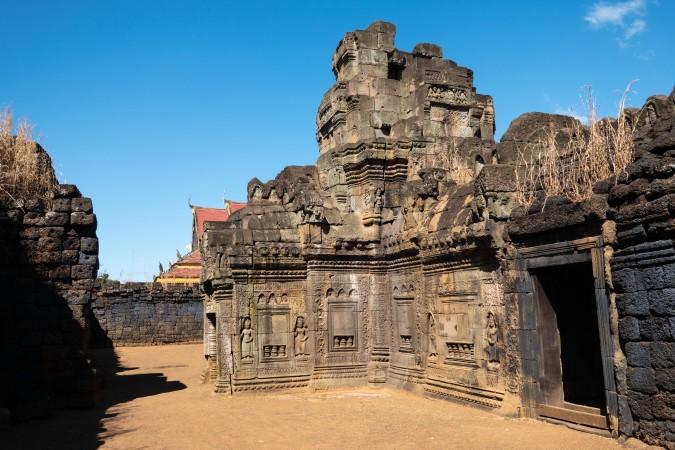
Wat Nokor temple - © PsamatheM
Top attractions in Kampong Cham
Kampong Cham, a picturesque town along the Mekong River, offers a captivating mix of history, culture, and natural beauty. From exploring ancient temples that echo the grandeur of Cambodia's past to experiencing unique local landmarks that showcase traditional craftsmanship, this town invites you to uncover its rich stories and scenic charm.
Wat Nokor Bachey
Location: 2.2 kilometers from Kampong Cham town along National Road 7
This ancient temple complex, built in the 11th century, showcases an impressive mix of Angkorian and Mahayana Buddhist architecture. The intricate carvings on the central tower are a testament to Cambodia’s rich cultural heritage. Visitors can explore its historical significance and experience the serene atmosphere that surrounds this important landmark.
Koh Pen Bamboo Bridge
Location: Spanning the Mekong River
Stretching about 1 kilometer across the Mekong River, the Koh Pen Bamboo Bridge is the longest bamboo bridge in the world. Rebuilt annually by local craftsmen, this marvel of traditional engineering offers stunning views of the river. The bridge is a vital part of local life, connecting villagers and offering travelers a unique and memorable experience.
Phnom Han Chey
Location: About 20 kilometers north of Kampong Cham city
Perched on a scenic hilltop, Phnom Han Chey offers breathtaking views of the Mekong River. Visitors climb 295 steps to reach the peaceful temple grounds, where they can explore the ancient structures and enjoy the tranquil surroundings. It’s an ideal spot for those seeking both cultural insight and panoramic vistas.
Kizuna Bridge
Location: Connecting Kampong Cham to Tbong Khmum
As the first bridge to cross the Mekong River in Cambodia, Kizuna Bridge opened in 2001 and has since become a symbol of progress. This vital link has enhanced trade and connectivity in the region. Beyond its practical significance, the bridge also offers stunning views of the river, making it a notable attraction for visitors.
Wat Joy T'maw
Location: Northern end of the riverside road, Kampong Cham
Wat Joy T'maw is a beautiful riverside temple known for its colorful wall paintings and detailed sculptures. Overlooking the Mekong River, this peaceful site is ideal for quiet reflection and provides an enriching glimpse into Cambodia’s deep-rooted cultural and religious traditions.
French Colonial Watchtower
Location: Along the banks of the Mekong River, Kampong Cham
Constructed in the early 1900s, this colonial-era watchtower offers sweeping views of Kampong Cham and the Mekong River. Visitors who climb to the top can not only enjoy the panoramic scenery but also connect with Kampong Cham’s colonial history, making it a fascinating stop for history lovers.
Wat Hancheay
Location: Approximately 20 kilometers north of Kampong Cham
Wat Hancheay is a tranquil hilltop pagoda that provides stunning views of the countryside and the Mekong River. Home to a community of young monks, it offers visitors the chance to experience local Buddhist practices in a serene setting, making it a meaningful cultural and spiritual visit.
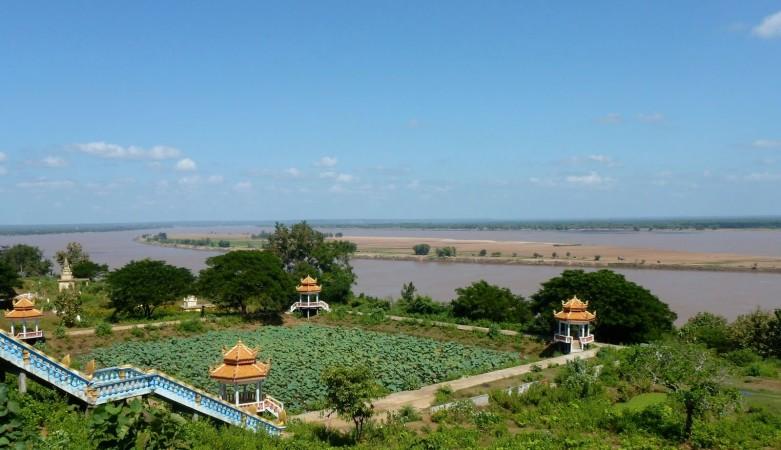
Wat Hancheay - © gather
Must-Try Dishes in Kampong Cham
In Kampong Cham, you’ll find a delightful array of traditional Cambodian dishes that reflect the region’s rich culinary heritage. From savory fish amok, a fragrant coconut curry steamed in banana leaves, to the unique flavors of prahok ktis, a creamy dip made with fermented fish and served with fresh vegetables, the local cuisine offers an authentic taste of Cambodia’s vibrant food culture.
Fish Amok
Fish Amok is one of Cambodia's most celebrated dishes, known for its delicate flavors and creamy texture. This fish curry is made with a blend of coconut milk, kroeung (a traditional Cambodian spice paste), and fresh fish, often steamed in banana leaves. The dish embodies the essence of Khmer cuisine, showcasing the use of local ingredients and aromatic spices. It is typically served with steamed rice and is a staple at festive occasions, symbolizing the cultural richness of the region.
Nom Banh Chok
Often referred to as "Khmer noodles," Nom Banh Chok is a popular breakfast dish consisting of thin rice noodles topped with a fragrant fish-based green curry. The curry is made from ingredients like lemongrass and turmeric, and it is garnished with fresh vegetables such as cucumbers and banana flowers. This dish is significant in local cuisine as it reflects the use of fresh, local produce and is a daily staple for many Cambodians, showcasing the region's agricultural abundance.
Kuy Teav
Kuy Teav is a beloved rice noodle soup that is commonly enjoyed for breakfast but can be eaten at any time of day. It features a savory broth (usually made with pork or beef) and is topped with a variety of garnishes, including herbs, bean sprouts, and lime. This dish illustrates the influence of neighboring Vietnamese cuisine while remaining distinctly Cambodian, highlighting the region's culinary diversity.
Lort Cha
Lort Cha is a stir-fried noodle dish that can be prepared with either meat or vegetables. The dish features short rice noodles, which are stir-fried with soy sauce, garlic, and a mix of vegetables, often served with a side of fresh herbs. It is a popular street food choice in Kampong Cham and reflects the local preference for quick, flavorful meals that utilize fresh ingredients.
Grilled Fish with Mango Salad
This dish showcases the region's fresh seafood, often caught from the Mekong River. The grilled fish is typically served with a refreshing mango salad, which adds a sweet and tangy contrast to the savory fish. This dish is significant as it highlights the local fishing culture and the importance of fresh produce in Kampong Cham's culinary landscape.
Fried Spiders
While it may sound unusual to some, fried spiders are a local delicacy in Kampong Cham. These crispy snacks are often seasoned with garlic and pepper and are popular among locals, especially during social gatherings. This dish represents the adventurous side of Cambodian cuisine and the use of unique local ingredients, reflecting the region's cultural practices and culinary creativity.
Learn more about other regions' cuisines in Cambodia here.
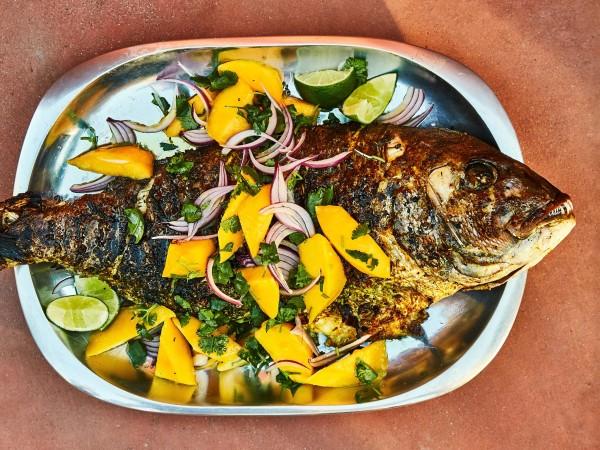
Grilled Fish with Mango Salad - © gather
Culture Etiquette in Kampong Cham
Greetings and Respect
The traditional greeting in Cambodia is the sampeah, where you press your palms together in a prayer-like gesture and bow slightly. This is a gesture of respect, particularly when greeting elders or in formal situations. Cambodians highly value respect for elders, so using polite language and deferential gestures is important when interacting with older individuals.
Dress Code
When visiting temples or rural areas, dressing modestly is important. Clothing should cover the shoulders and knees to show respect for local customs. Revealing outfits are discouraged, particularly in religious or formal settings.
Dining Etiquette
In Cambodian culture, it’s customary to eat with your right hand, as the left hand is considered unclean. When using utensils, a fork and spoon are preferred, with the fork pushing food onto the spoon. Meals are often shared communally, so it’s polite to wait for the host to begin eating before you start and to be open to trying different dishes.
Bargaining and Shopping
Bargaining is a common practice in local markets. Visitors are encouraged to approach negotiations with a friendly attitude, starting with a smile and polite greeting. Keep the tone light and respectful during haggling, as it’s considered part of the shopping experience in Cambodia.
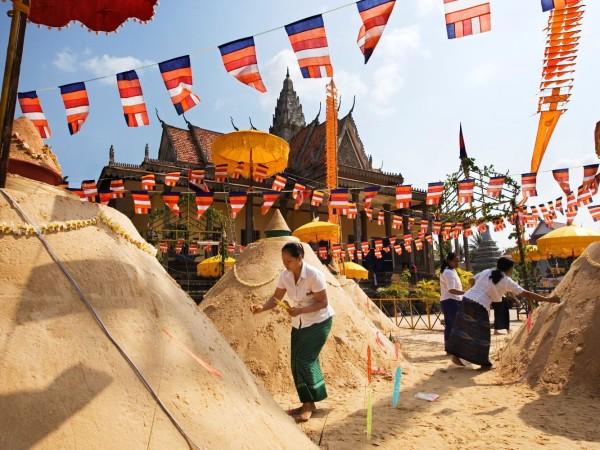
Chol Chnam Thmey - © gather
Weather in Kampong Cham: Best Time to Visit
Average Temperatures
- Cool Season (November to February): Average temperatures range from 17°C to 27°C (63°F to 81°F).
- Hot Season (March to May): Average temperatures range from 28°C to 36°C (82°F to 97°F).
- Rainy Season (May to October): Average temperatures range from 27°C to 35°C (81°F to 95°F).
Rainfall
- Wet Season: Heavy rainfall is common, particularly from May to October.
- Dry Season: Runs from November to April, with minimal rainfall.
Humidity
- Humidity levels are generally high throughout the year, peaking during the rainy season.
Best time to travel
The best time to travel to Kampong Cham is during the dry season, which typically runs from November to February. This period is characterized by cooler temperatures and lower humidity, making it ideal for outdoor activities and exploration.
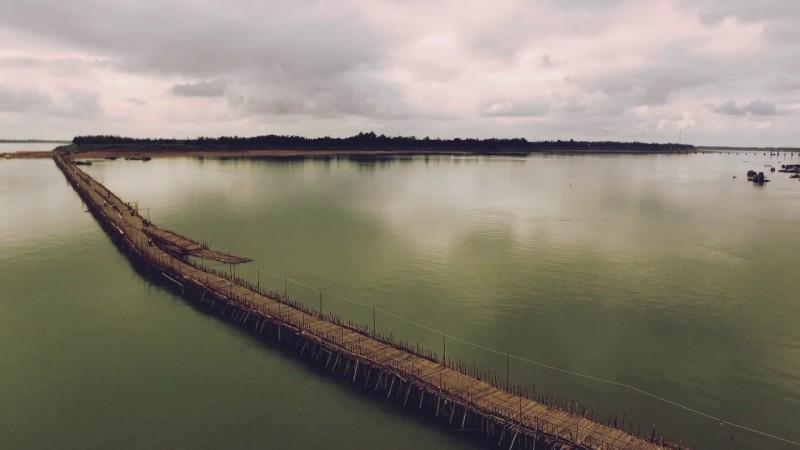
Kampong Cham - © gather
Festivals & Local Celebrations
Khmer New Year (Chaul Chnam Thmey)
When: April (usually around the harvest season)
Cambodia's most popular event, the Khmer New Year is celebrated for three days in Kampong Cham. Numerous religious rituals take place in temples and pagodas, with many people visiting to pay their respects. In the city, shops and businesses close, but there are festivities on the streets with food, traditional games, and music. Some locals have a tradition of climbing the +300 steps at Phnom Srey for the
New Year and other holidays.
Pchum Ben (Soul Day or Ancestors Day)
When: September or October (a 15-day festival)
During this Buddhist festival, Cambodians pay respects to deceased relatives. People bring food offerings to temples and pagodas, and it is more of a family affair than a public celebration. However, visitors will notice the flurry of activity and offerings happening in religious locations throughout the city, with people wearing their best brightly colored clothes.
Mekong River Festival
When: Varies by location (the festival travels to a different city along the Mekong each year)
When held in Kampong Cham, this festival involves a gala with sporting activities and many riverside festivities to pay tribute to Asia's seventh longest river. The festival aims to raise awareness about the importance of the Mekong River to the region.
Discover more festivals around Cambodia here.
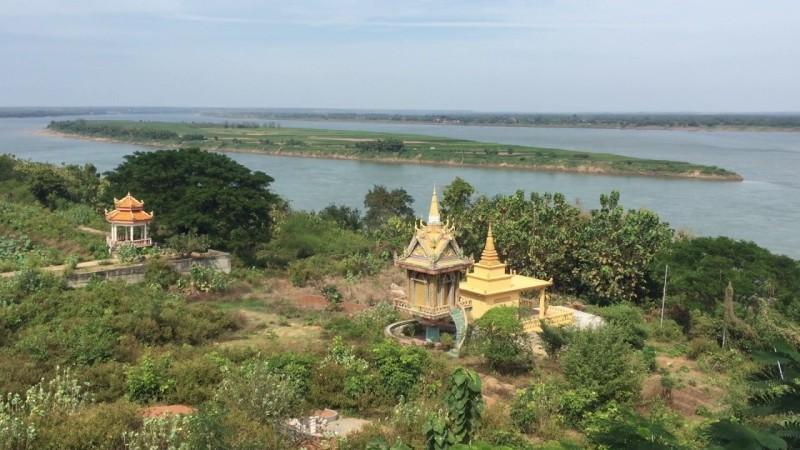
Phnom Han Chey - © gather
Essential Travel Information
Getting Around Kampong Cham
- Tuk-tuks: Tuk-tuks are the primary mode of transportation within Kampong Cham and can be found easily on the streets or arranged through your hotel. Be sure to negotiate and agree on the fare before starting your trip to avoid misunderstandings.
- Motorbike Taxis: Known locally as "moto-dups," motorbike taxis are a cheap and efficient way to get around the city. They are perfect for short trips, though they may not be as comfortable for longer journeys.
- Bicycle Rentals: Many guesthouses and hotels in Kampong Cham offer bicycle rentals, providing a great way to explore the city and nearby attractions. The flat terrain makes cycling an enjoyable and eco-friendly option.
- Walking: Kampong Cham is a compact city, with many attractions close to each other. Walking is a good option for shorter distances, particularly in the early morning or late afternoon when the weather is cooler.
ATM and Banking Services in Kampong Cham
- ATM Availability: ATMs are easily accessible in Kampong Cham, especially in the city center. Major banks like Acleda Bank, Canadia Bank, and Wing Bank provide ATM services to both locals and tourists.
- Currency Options:Most ATMs in Kampong Cham dispense both US Dollars and Cambodian Riel. US Dollars are widely accepted across the city, making transactions easy for international travelers.
- ATM Fees: If you’re using an international card, keep in mind that transaction fees may apply. It's a good idea to check with your home bank about potential withdrawal fees before your trip.
- Banking Services: Several banks in Kampong Cham offer basic banking services. Additionally, mobile banking and digital payment options are becoming more common, which can be particularly convenient for visitors.
Accommodation Choices in Kampong Cham
Kampong Cham offers a variety of accommodation options, catering to different budgets:
- Mid-range Hotels: You’ll find several comfortable mid-range hotels in the city center, providing essential amenities for a relaxing stay.
- Budget-Friendly Options: For travelers on a budget, there are guesthouses and budget hotels that offer affordable, no-frills lodging.
- Riverside Accommodations: Some accommodations along the Mekong River offer scenic views, providing a peaceful setting close to the water.
- Amenities: Many hotels and guesthouses offer free Wi-Fi, though the connection quality may vary. Some properties also offer bicycle rentals, giving you a convenient way to explore the city at your own pace.
Articles for you

Explore Yala National Park - Sri Lanka Travel, Asia
Tucked away in Sri Lanka’s southeastern corner, Yala National Park is where wild nature meets deep tradition. Known worldwide for its leopard population, the park is also home to elephants, sloth bears, crocodiles, and hundreds of bird species. Beyond wildlife, Yala opens doors to a cultural landscape dotted with ancient temples, Buddhist ruins, and coastal villages. For travelers seeking more than just a safari, Yala offers a chance to explore eco-tourism, local communities, and sacred heritage sites.
Population: The Yala National Park area doesn’t have a human population.
Economy: The economy around Yala National Park thrives on a blend of eco-tourism, agriculture, and local services. Safari tours, eco-lodges, and cultural experiences drive steady income for nearby towns like Tissamaharama and Kataragama, supporting thousands of families.
Landmarks: Famous for Block I of Yala and wildlife encounters, including elephants, sloth bears, crocodiles, and exotic bird species.

Explore Galle - Sri Lanka Travel, Asia
Nestled on Sri Lanka’s southern coastline, Galle is a vibrant city where history meets the sea. Its cobbled streets, colonial architecture, and serene beaches make it a must-visit destination for travelers seeking a blend of culture, adventure, and relaxation. A UNESCO World Heritage site, Galle captivates visitors with its Dutch Fort, bustling markets, and friendly locals. Whether you’re exploring the ramparts at sunset or savoring fresh seafood by the shore, Galle promises an unforgettable journey into Sri Lanka’s heritage.
Population: Approximately 113,000 in 2023.
Economy: Galle’s economy thrives on tourism, trade, and fisheries. The city’s historic fort, colonial architecture, and coastal charm draw thousands of international visitors each year, making tourism its main economic driver. Fishing remains vital for local livelihoods, supplying fresh seafood across the region.
Landmarks: Famous for the Galle Fort, Dutch Reformed Church & Maritime Museum, and Unawatuna Beach.

Explore Bentota - Sri Lanka Travel, Asia
Nestled along Sri Lanka’s southwestern coast, Bentota is a tropical paradise that blends golden beaches, vibrant culture, and thrilling adventures. Famous for its calm waters, luxury resorts, and scenic river estuary, Bentota has become a top destination for travelers seeking both relaxation and authentic experiences. From serene beach walks at sunrise to adrenaline-pumping water sports, this coastal town offers a perfect balance of leisure and exploration. With its proximity to Colombo and Galle, Bentota is easy to reach, making it an ideal stop for both short escapes and extended holidays.
Population: Approximately 37,000 in 2023.
Economy: Bentota’s economy thrives mainly on tourism, which drives local businesses such as hotels, restaurants, and wellness retreats. The town also benefits from fishing, coconut cultivation, and handicrafts like wood carving and batik textiles. Many residents rely on the growing demand for water sports and Ayurvedic treatments, making tourism the backbone of both income and employment in the area.
Landmarks: Famous for Bentota Beach, Bentota River Safari, and Kande Vihara Temple.

Explore Mirissa - Sri Lanka Travel, Asia
Mirissa is a charming coastal town on Sri Lanka’s southern shoreline. Known for its golden beaches, turquoise waters, and vibrant marine life, it has become a must-visit stop for travelers exploring the island. Many come for whale watching, surfing, and sunset views at Coconut Tree Hill, but Mirissa offers much more than postcard beauty. The fishing boats you see anchored by the bay carry generations of stories. Local traditions, delicious cuisine, and a laid-back rhythm of life shape every visitor’s experience.
Population: Approximately 4,700 in 2023.
Economy: Mirissa’s economy is largely shaped by its coastal location. Fishing has long been the backbone of local livelihoods, with generations relying on the Indian Ocean for income. In recent decades, tourism has become the main driver of growth, thanks to whale watching, surfing, and beachside hospitality.
Landmarks: Famous for Mirissa Beach, Coconut Tree Hill, and Parrot Rock Bridge.

Explore Nuwara Eliya - Sri Lanka Travel, Asia
Tucked away in the Central Highlands of Sri Lanka, Nuwara Eliya is often called “Little England”. With its rolling tea plantations, cool misty mornings, and colonial charm, this mountain town feels like a step into another world. Travelers come here to breathe fresh air, walk through flower gardens, sip the finest Ceylon Tea, and enjoy a pace of life far from the island’s busy cities. Whether you’re drawn by scenic landscapes, heritage architecture, or the warmth of its people, Nuwara Eliya is a destination that blends nature, culture, and history in perfect harmony.
Population: Approximately 781,000 in 2023.
Economy: Nuwara Eliya’s economy thrives mainly on tea production, as it sits in the heart of Sri Lanka’s central highlands, famous worldwide for Ceylon Tea. The city also benefits from a growing tourism industry, attracting visitors with its colonial charm, cool climate, and scenic landscapes.
Landmarks: Famous for Gregory Lake, Hakgala Botanical Garden, and Victoria Park.

Explore Sukau - Malaysia Travel, Asia
Nestled on the banks of the Kinabatangan River in Sabah, Malaysian Borneo, Sukau is a destination where wildlife, culture, and conservation come together. Known as one of Asia’s top spots for river safaris and eco-tourism, this quiet village offers a front-row seat to encounters with Bornean orangutans, pygmy elephants, proboscis monkeys, and exotic birdlife.
Population: Approximately 1,400 in 2019.
Economy: Sukau’s economy is shaped by its riverine location and natural resources. Traditionally, the Orang Sungai community relied on fishing, small-scale farming, and forest gathering for their livelihood. Today, the village has shifted toward eco-tourism, with river cruises, jungle trekking, and homestays providing income.
Landmarks: Famous for the Kinabatangan River cruises, Gomantong Caves, and Ox-bow lakes and wetlands.
